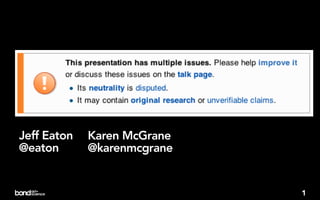
Notas del editor
- \n
- \n
- \n
- Early days of the web, browser wars, costly custom code to make sites work across browsers and platforms\nThis started with dialup BBS, moved to online services, should you develop for web or AOL?\n
- Eventually the browser wars settled down, web standards arose, and businesses became able to develop more consistently \nThis was a solution FOR FRONT END DEVELOPERS. Solved the code problem, not the content problem.\n\nAny time you put yourself in a position of building for two different platforms, you are back in that world.\n
- On the content side, still have clunky, static content management. \nInformation that used to be locked up in print documents is now locked up in “web pages” or PDFs\nContent creators still think about text as documents, in pages\n
- crazy diversity of screen sizes, platforms, OSes\nhaving the same arguments all over again\n“most users on AOL” “but if we do it on the web, everyone can see it”\ndifferent input styles\n
- Diverse screen sizes is a problem that is not going to go away. It is going to get worse.\nDifferent device capabilities across OSes\n
- \n
- \n
- One way people talk about how to prioritize is by talking about what people want to do when they’re “mobile”\n
- Mobile supports different contexts, not just 'on the go or in your office.'\nMobile supports contemplative, thoughtful interactions as much as it does fast-paced, on the go\n\n
- iPad on the couch\n\n
- Laptop on crap hotel wifi\n\n
- TV browsing (via Xbox, for example)\nThis, perplexingly, also needs to be thought about under the guise of “mobile”\n
- Smartphone on the train\n\n
- \n
- There is no mobile version\n•Thinking about a "mobile version" of your website is already outmoded\n•Always going to be a new device, platform, new behaviors, interactions\n•Just like adding a few "share" links to your news site is not a solution to a fundamentally non-interactive model\n•Building "a mobile site" or "a mobile app" isn't going to help if you're not thinking about you content as a store to deliver in different ways\n•You need to treat your content as a pool that a given design or app can draw on, rather than puzzle pieces that fit into the 'blank spots' in a fixed design or designs.\n\n
- \n
- Three things\n
- Every generation thinks that its problems are the big ones\nEvery generation on the web thinks that its transformation is THE BIG ONE\n
- \n
- Separation of content and form. For real this time.\n•Breaking down what you have and decoupling it from the design is the way you avoid desperate rebuilding when a new device or a new use model emerges\n•If you don't do the groundwork, design/app decisions and maintenance will be punishing. Like publishing another tiny little magazine\n•Isolate slices of content that make sense for a given use case. Local recipe guide? Martha Stewart? They have a huuuuuge archive of content in the form of recipes, stuff, etc. Spin uses their most popular content in the iPad app.\n\n
- Web standards don’t protect you from yourself, like pasting a Dreamweaver page into your content input form\n“We just want to copy a document in from Word with all the formatting intact”\nYou can use web standards to make something that will break as soon as you try to redeploy it in another channel\n
- \n
- Lives at the design level, not your content\nEthan Marcotte’s book, Responsive Web Design, comes out tomorrow\n
- \n
- \n
- ▼❑1Are apps the answer?\n•❑1.1Is it primarily content? Or actions/behaviors?\n•❑1.2hard to share, takes a lot of investment\n•❑1.3But... it's also easier if you're really device agnostic and serving data\n\n
- \n
- \n
- More like an ad buy than selling the publication\n
- What the who now?\nCMS vs. API - Why doesn’t it do that already?\nMost CMSs manage and present, an API exposes your content before the ‘present’ part.\n
- \n
- \n
- \n
- \n
- \n
- \n
- \n
- \n
- \n
- \n
- \n
- \n
- \n
- \n
- \n
- \n
- \n
- \n
- \n
- \n
- \n
- \n
- \n
- Editorial issues\n•Shift from "pages" to "reusable content chunks" is difficult for people to grasp, even people who use the CMS\n•Metadata, taxonomy, content model — snooze\n•How do we educate content creators about what it means to have different atomic chunks of content\n
- \n
- \n
- \n
- \n
- Ad sizes, formats across different devices\nAlready not making enough online\nMobile is worse\n
- Ad sizes, formats across different devices\nAlready not making enough online\nMobile is worse\n
- \n
- \n
- \n
